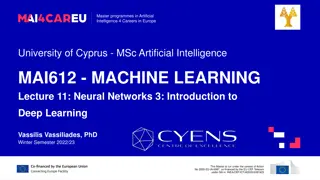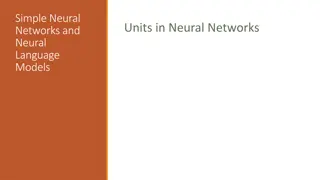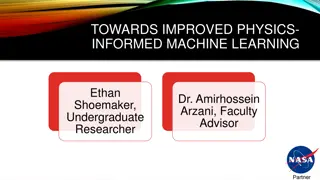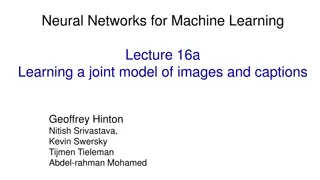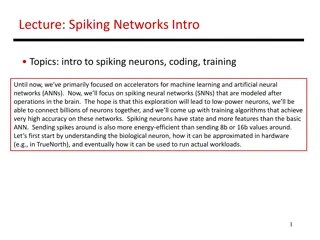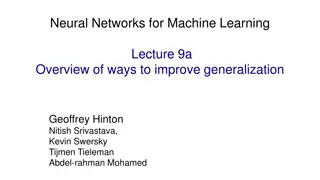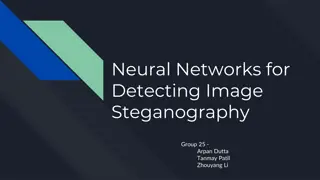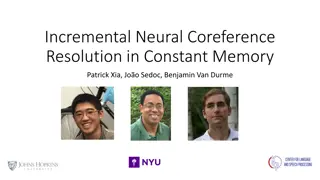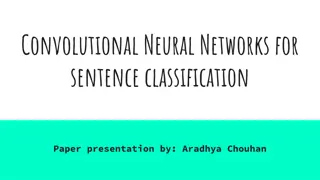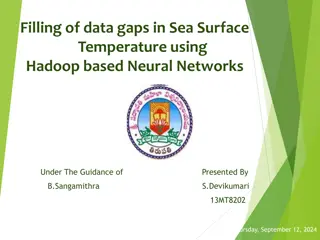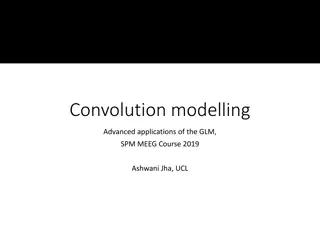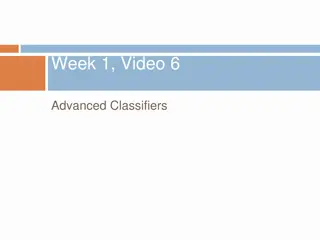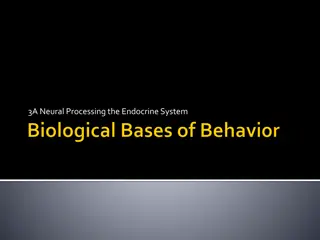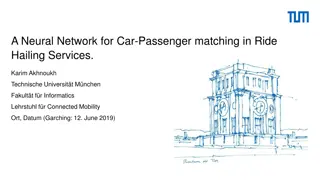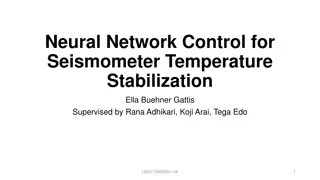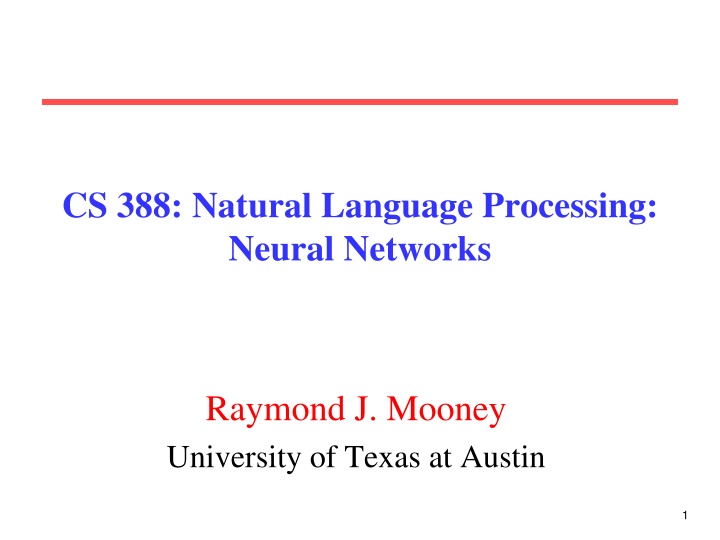
Neural Networks and Learning Approaches in Natural Language Processing
Explore the world of neural networks and their learning approaches in the realm of natural language processing. Delve into topics like neural communication, artificial neuron models, and perceptron training to gain insights into how these systems function and evolve. Discover the basics of biological neural systems and their computational counterparts, paving the way for a deeper understanding of this fascinating field.
Download Presentation

Please find below an Image/Link to download the presentation.
The content on the website is provided AS IS for your information and personal use only. It may not be sold, licensed, or shared on other websites without obtaining consent from the author. If you encounter any issues during the download, it is possible that the publisher has removed the file from their server.
You are allowed to download the files provided on this website for personal or commercial use, subject to the condition that they are used lawfully. All files are the property of their respective owners.
The content on the website is provided AS IS for your information and personal use only. It may not be sold, licensed, or shared on other websites without obtaining consent from the author.
E N D
Presentation Transcript
CS 388: Natural Language Processing: Neural Networks Raymond J. Mooney University of Texas at Austin 1
Neural Network Learning Learning approach based on modeling adaptation in biological neural systems. Perceptron: Initial algorithm for learning simple neural networks (single layer) developed in the 1950 s. Backpropagation: More complex algorithm for learning multi-layer neural networks developed in the 1980 s. 2
Real Neurons Cell structures Cell body Dendrites Axon Synaptic terminals 3
Neural Communication Electrical potential across cell membrane exhibits spikes called action potentials. Spike originates in cell body, travels down axon, and causes synaptic terminals to release neurotransmitters. Chemical diffuses across synapse to dendrites of other neurons. Neurotransmitters can be excititory or inhibitory. If net input of neurotransmitters to a neuron from other neurons is excititory and exceeds some threshold, it fires an action potential. 4
Simple Artificial Neuron Model (Linear Threshold Unit) Model network as a graph with cells as nodes and synaptic connections as weighted edges from node i to node j, wji 1 Model net input to cell as w12 w16 w15 w13w14 = net w o j ji i 2 3 4 5 6 i Cell output is: oj if 0 net T j j = o 1 j if 1 net T i j (Tjis threshold for unit j) 0 Tj netj 5
Perceptron Training Assume supervised training examples giving the desired output for a unit given a set of known input activations. Learn synaptic weights so that unit produces the correct output for each example. Perceptron uses iterative update algorithm to learn a correct set of weights. 6
Perceptron Learning Rule Update weights by: w w = + ( ) t o o ji ji j j i where is the learning rate tj is the teacher specified output for unit j. Equivalent to rules: If output is correct do nothing. If output is high, lower weights on active inputs If output is low, increase weights on active inputs Also adjust threshold to compensate: ( j j j o t T T = ) j 7
Perceptron Learning Algorithm Iteratively update weights until convergence. Initialize weights to random values Until outputs of all training examples are correct For each training pair, E, do: Compute current output oj for E given its inputs Compare current output to target value, tj , for E Update synaptic weights and threshold using learning rule Each execution of the outer loop is typically called an epoch. 8
Perceptron as a Linear Separator Since perceptron uses linear threshold function, it is searching for a linear separator that discriminates the classes. o3 + w o w o T 12 2 13 3 1 ?? w T + 12 1 o o 3 2 w w 13 13 Or hyperplane in n-dimensional space o2 9
Concept Perceptron Cannot Learn Cannot learn exclusive-or, or parity function in general. o3 1 + ?? + 0 o2 1 10
Perceptron Convergence and Cycling Theorems Perceptron convergence theorem: If the data is linearly separable and therefore a set of weights exist that are consistent with the data, then the Perceptron algorithm will eventually converge to a consistent set of weights. Perceptron cycling theorem: If the data is not linearly separable, the Perceptron algorithm will eventually repeat a set of weights and threshold at the end of some epoch and therefore enter an infinite loop. By checking for repeated weights+threshold, one can guarantee termination with either a positive or negative result. 11
Perceptron as Hill Climbing The hypothesis space being search is a set of weights and a threshold. Objective is to minimize classification error on the training set. Perceptron effectively does hill-climbing (gradient descent) in this space, changing the weights a small amount at each point to decrease training set error. For a single model neuron, the space is well behaved with a single minima. training error 0 weights 12
Threshold to Bias Threshold can be converted to an additional bias weight on an additional constant 1 input (o0=1) j i i 0 + j i i i i w o T ji i j i 0 w o T ji w o b ji 0 w jio Where sum now includes i=0 and wj0=bj 13
Multi-Layer Feed-Forward Networks Multi-layer networks can represent arbitrary functions, but an effective learning algorithm for such networks was thought to be difficult. A typical multi-layer network consists of an input, hidden and output layer, each fully connected to the next, with activation feeding forward. output activation hidden input The weights determine the function computed. Given an arbitrary number of hidden units, any boolean function can be computed with a single hidden layer. 14
Hill-Climbing in Multi-Layer Nets Since greed is good perhaps hill-climbing can be used to learn multi-layer networks in practice although its theoretical limits are clear. However, to do gradient descent, we need the output of a unit to be a differentiable function of its input and weights. Standard linear threshold function is not differentiable at the threshold. oi 1 0 Tj netj 15
Differentiable Output Function Need non-linear output function to move beyond linear functions. A multi-layer linear network is still linear. Standard solution is to use the non-linear, differentiable sigmoidal logistic function: 1 net = 1 o j jT ( ) + 1 e j 0 Tj netj Can also use tanh or Gaussian output function 16
Gradient Descent Define objective to minimize error: E = 2) ( ) ( W t o kd kd d D k K where D is the set of training examples, K is the set of output units, tkd and okd are, respectively, the teacher and current output for unit k for example d. The derivative of a sigmoid unit with respect to net input is: o = j 1 ( j ) o o j net j Learning rule to change weights to minimize error is: E = w ji w ji 17
Backpropagation Learning Rule Each weight changed by: w = o ji j i = = 1 ( j 1 ( j )( ) ) kj if if output an is j hidden a is j unit unit o o o o t o w j j j j j j k k where is a constant called the learning rate tj is the correct teacher output for unit j j is the error measure for unit j 18
Error Backpropagation First calculate error of output units and use this to change the top layer of weights. Current output: oj=0.2 Correct output: tj=1.0 Error j = oj(1 oj)(tj oj) 0.2(1 0.2)(1 0.2)=0.128 output Update weights into j w = hidden o ji j i input 19
Error Backpropagation Next calculate error for hidden units based on errors on the output units it feeds into. output k = 1 ( ) o o w j j j k kj hidden input 20
Error Backpropagation Finally update bottom layer of weights based on errors calculated for hidden units. output k = 1 ( ) o o w j j j k kj hidden Update weights into j w = o ji j i input 21
Backpropagation Training Algorithm Create the 3-layer network with H hidden units with full connectivity between layers. Set weights to small random real values. Until all training examples produce the correct value (within ), or mean squared error ceases to decrease, or other termination criteria: Begin epoch For each training example, d, do: Calculate network output for d s input values Compute error between current output and correct output for d Update weights by backpropagating error and using learning rule End epoch 22
Comments on Training Algorithm Not guaranteed to converge to zero training error, may converge to local optima or oscillate indefinitely. However, in practice, does converge to low error for many large networks on real data. Many epochs (thousands) may be required, hours or days of training for large networks. To avoid local-minima problems, run several trials starting with different random weights (random restarts). Take results of trial with lowest training set error. Build a committee of results from multiple trials (possibly weighting votes by training set accuracy). 23
Hidden Unit Representations Trained hidden units can be seen as newly constructed features that make the target concept linearly separable in the transformed space. On many real domains, hidden units can be interpreted as representing meaningful features such as vowel detectors or edge detectors, etc.. However, the hidden layer can also become a distributed representation of the input in which each individual unit is not easily interpretable as a meaningful feature. 24
Over-Training Prevention Running too many epochs can result in over-fitting. error on test data on training data 0 # training epochs Keep a hold-out validation set and test accuracy on it after every epoch. Stop training when additional epochs actually increase validation error. To avoid losing training data for validation: Use internal 10-fold CV on the training set to compute the average number of epochs that maximizes generalization accuracy. Train final network on complete training set for this many epochs. 25
Determining the Best Number of Hidden Units Too few hidden units prevents the network from adequately fitting the data. Too many hidden units can result in over-fitting. error on test data on training data 0 # hidden units Use internal cross-validation to empirically determine an optimal number of hidden units. 26
Recurrent Neural Networks (RNN) Add feedback loops where some units current outputs determine some future network inputs. RNNs can model dynamic finite-state machines, beyond the static combinatorial circuits modeled by feed-forward networks. 27
Simple Recurrent Network (SRN) Initially developed by Jeff Elman ( Finding structure in time, 1990). Additional input to hidden layer is the state of the hidden layer in the previous time step. http://colah.github.io/posts/2015-08-Understanding-LSTMs/ 28
Unrolled RNN Behavior of RNN is perhaps best viewed by unrolling the network over time. time 29
Training RNNs RNNs can be trained using backpropagation through time. Can viewed as applying normal backprop to the unrolled network. y2 y0 y1 training outputs yt B B B B training inputs backpropagated errors 30
Conclusions Feed forward neural networks are a powerful machine learning technique for feature-vector classification. Training becomes increasingly difficult as the number of neural layers increases. Perceptron for training a single layer network Backpropagation for multi-layer networks Recurrent neural networks can perform sequence modeling and labeling, but backpropagation thru time has problems training unrolled networks that are deep in time. 31

